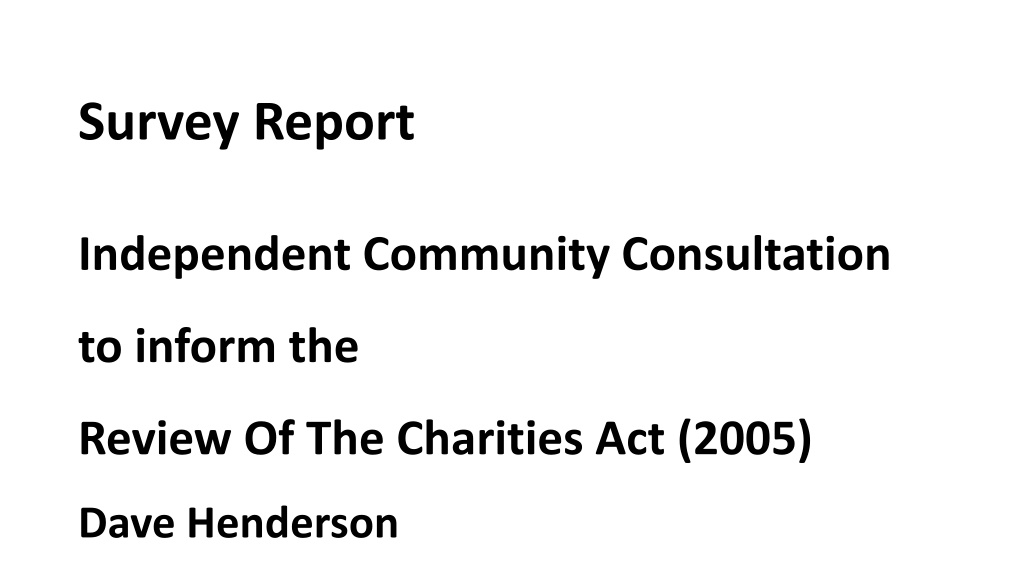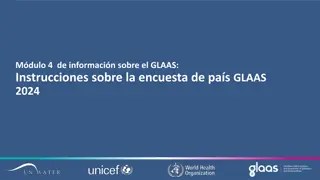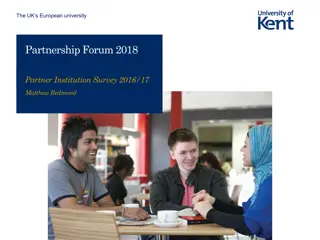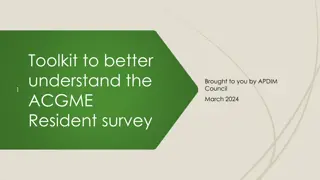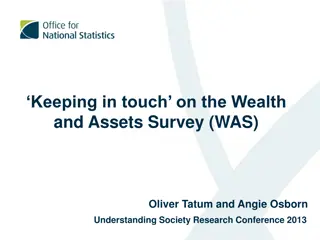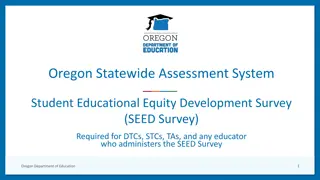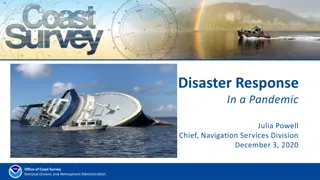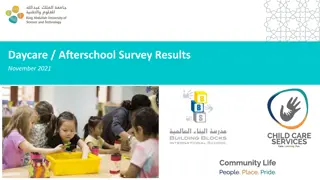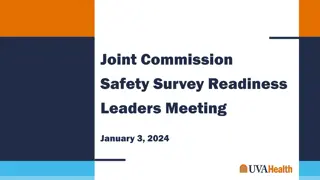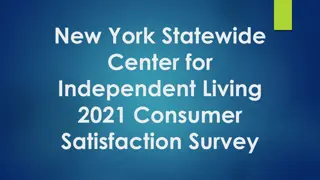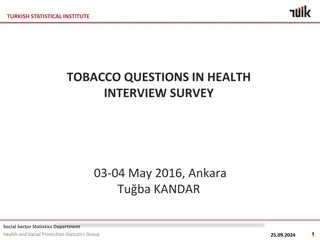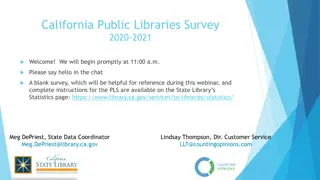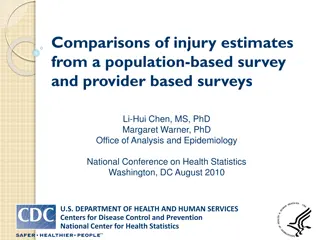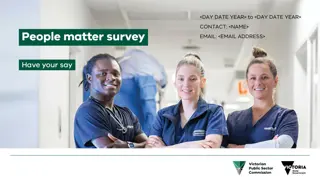Survey Report
This report summarizes the findings of an independent community consultation aimed at informing the review of the Charities Act (2005). Key points include feedback on the Act's purposes, satisfaction levels among charities, and challenges faced by different organizations in the sector.
Download Presentation

Please find below an Image/Link to download the presentation.
The content on the website is provided AS IS for your information and personal use only. It may not be sold, licensed, or shared on other websites without obtaining consent from the author.If you encounter any issues during the download, it is possible that the publisher has removed the file from their server.
You are allowed to download the files provided on this website for personal or commercial use, subject to the condition that they are used lawfully. All files are the property of their respective owners.
The content on the website is provided AS IS for your information and personal use only. It may not be sold, licensed, or shared on other websites without obtaining consent from the author.
E N D
Presentation Transcript
Survey Report Independent Community Consultation to inform the Review Of The Charities Act (2005) Dave Henderson
Project Framework Strategic Grants worked as an independent external evaluator with the purpose of assisting Dave Henderson of Trust Democracy and Sue Barker of Sue Barker Charities Law. We received support from a consortium of 12 philanthropic trusts to undertake national community consultation. We are both members of DIA s Core Reference Group for the review. The national survey was undertaken independently, with a view to gathering empirical evidence to feed in to the review. The survey and report were produced as a Pro Bono service by Strategic Grants to summarise key points from the sector s views.
Data Collection Link to survey distributed through community networks: 662 surveys logged 577 respondents provided comprehensive data. 30% Charitable Trust Boards (Charitable Trusts Act 1957) 28% Incorporated Societies 22% Society (incorporated under Charitable Trusts Act 1957) 11% Other: Philanthropic trusts, Community based donors, Fundraisers, Religious entities, Lawyers, Unsure (Incorporated Societies Act 1908)
The Respondents 20% organisations with 0 paid staff all volunteers 38% organisations with 1 5 paid staff 18% organisations with 6 15 paid staff 24% organisations with more than 16 paid staff 87% are a registered charity 14% not registered: Registration refused - n48; Application withdrawn n2; Never applied n39 Deregistered n2
Purposes of the Act Majority satisfaction among larger charities: helpful, good, fine. While satisfied, the same respondents sought further purposes; to educate and support professionalism, encourage best practice, provide active guidance and provide assistance around legal requirements. Tier 3 and Tier 4: Reporting and administration requirements are problematic, especially for poor and volunteer-based charities. Overall, registration as a charitable entity viewed as onerous, costly, a politicisation, and the criteria quite far-reaching .
Existing Purposes (1) Promote public trust and confidence in the charities sector. While a worthy purpose, there needs to be a strong consistency over time. If some historic organisations have charitable status and other, more recent, almost identical organisations are not granted it the public could have concerns about the process and question the validity of both organisations, with the overall effect of reducing confidence in the charitable sector
Existing Purposes (2) Encourage and promote the effective use of charitable resources Again, a worthy aim, but in practice Charities Services, in their interpretation of the Act, seems to be putting up unnecessarily high barriers to registration, so that worthy would-be charities are having to expend a lot of time, energy and financial resources trying to get registered. Worthy would-be would-be charities without sufficient initial backing, would not be able to pass the first hurdle of registration
Other possible Purposes Promote the charitable sector and engender public and government confidence; Greater or expanded definition/clarification of charitable purpose, public benefit, and charitable status, to specifically include advocacy; Provide information, support and education to charities on best practice governance and management; I think DIA has a role to play in education and improving the performance/capability of the sector Collect, analyse and publish data on the charitable sector to acknowledge the work achieved and champion best practice
Structure of the Government Agency 357 respondents: 43% - it should be an Autonomous Crown Entity, as was the earlier Charities Commission; 30% - it should be a government department plus CRB, as at present; 15% - it should be an Independent Crown Entity, as was sought be the sector in the years leading up to the 2005 Act; 12% - other suggestions.
Structure agency classification Working Party on Registration and Monitoring of Charities 2002, p9: It is our strong view that a Charities Commission would be most acceptable to the charitable sector. This is important as it would mean the costs of monitoring and enforcement are likely to be less if the sector supports and has confidence in the organisation. Any lesser alternative would fail to adequately recognise the importance and independence of the charitable sector.
Appeal Processes and Decisions 285 respondents: 83% supported an independent specialist Charities Tribunal When asked to explain the things that are fair or unfair, concerns raised re mechanisms, the process, timing, bias, and costs: The limited time (to register an appeal) is ridiculous, the process is not feasible for many charities and is therefore unjust. It seems there is political bias in some of the CRB s actions!! An appeals process should allow for an external board to reconsider what charities services has decided. An appeal should require a different set of people.
Deregistration and Refusals Deregistration reasons: lack of advantage for our organisation in being registered failure to file our annual return 52% of respondents support interim sanctions as an alternative to deregistration; Suspension would be preferable, to ease re-registration Refusal reasons: Undertaking advocacy activities Not meeting criteria as providing public benefit
Extent to which reg. charities can Advocate 59% of respondents feel the fact they are registered is moderately or very influential on their capacity to advocate. We believe that being charitable requires us to advocate for the addressing of the causes of the problems that impact the people we work with. Applying a bandaid without addressing the thing that causes the problem is just stupid in the long term. Advocacy is part of being a charity it needs to be protected in law
